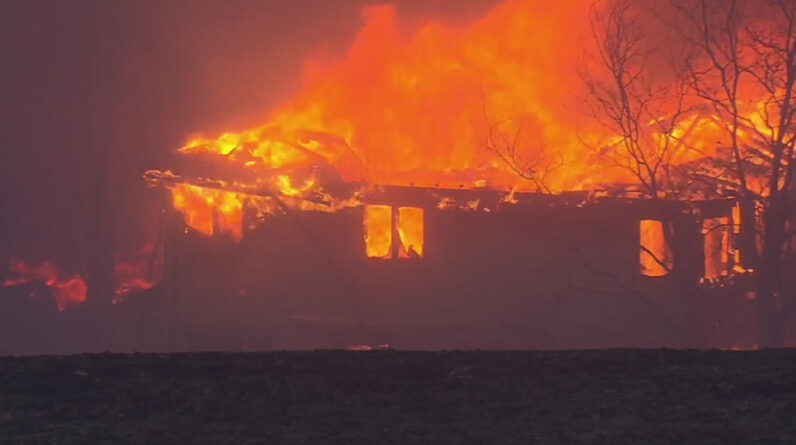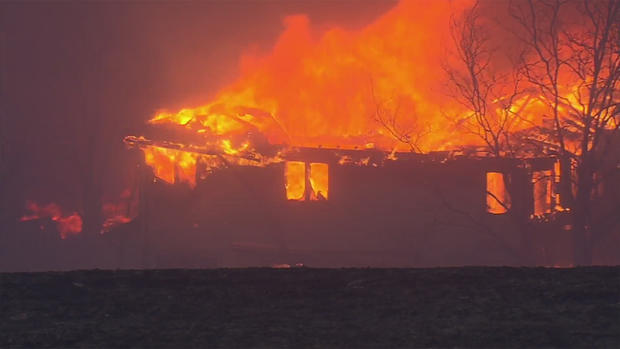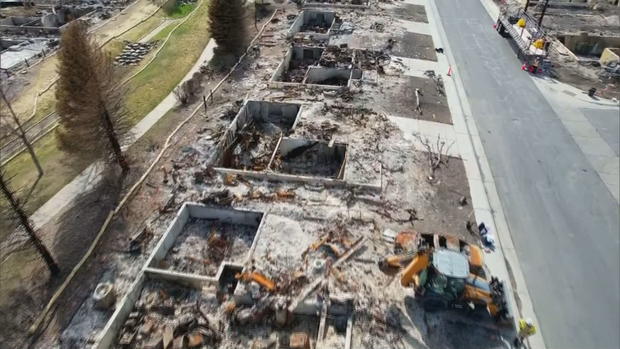
The Marshall Fire destroyed more than 1,000 homes in Boulder County in December 2021. The Boulder County Sheriff’s Office is now providing an update on the cause of the most destructive wildfire in Colorado history.
Thursday morning, the Boulder County Sheriff announced that the Marshall Fire was composed of two fires with two different origins.
CBS
“I can say with confidence that we know what happened and why,” Boulder County Sheriff Curtis Johnson said. “The Marshall Fire was actually composed of two fires.”
The first started at a property at 5325 Eldorado Springs Drive six days before the Dec. 24 Marshall Fire, which was composed of tree limbs. A passerby saw the fire and called the authorities. Firefighters with Mountain View Fire determined that the fire was no longer burning at that time due to covering the fire with dirt and other measures taken to extinguish the fire.
During the investigation into the Marshall fire, investigators determined that the fire continued to burn for days and people living on the property tried to put out the fire once they realized it was still burning on December 30. The fire was fueled by strong winds and continued to spread.
About an hour later, a second fire started south of the Marshall Mesa trailhead, ignited by hot particles discharged from an Xcel Energy power line.
“The two fires became one fire at some point, but there’s no way to determine when or where that happened,” Johnson said.
The district attorney said no criminal charges will be filed in connection with the Marshall Fire investigation.
“If I were to announce that charges are being filed today, that would be wrong and unethical,” said 20th Judicial District Attorney Michael Dougherty.
RELATED: Marshall Fire victim fights once again to stop foreclosure on her property
Two people died in that fire that burned 6,080 hectares. Thirty-five thousand people were evacuated that day and thousands of animals, including pets, died in the fire. There was a high wind advisory that day, with wind gusts reaching over 100 mph in Boulder County.
“There is no evidence that the residents of 5325 Eldorado Springs Drive set the fire on Dec. 30,” Dougherty said. “Incredibly thorough research was done on this property.”
The @BldrCOSheriff conducted a thorough investigation of the Marshall fire. The sheriff’s office received invaluable assistance from the US Forest Service, electrical engineers, experts and other agencies.
The results have been sharedhttps://t.co/U4zNUil5dz
— Boulder District Attorney (@DABoulder20th) June 8, 2023
On Dec. 24, Dougherty said the weather was wet, cool and rainy, and residents did not break any laws. The rules for extinguishing fires on private property have been updated to include more comprehensive measures.
The following is Xcel Energy’s statement regarding today’s Marshall Fire press conference: “Our thoughts are with the families and communities affected by the devastating wildfire in Boulder County. We agree with Boulder County Sheriff’s Office report that the Marshall fire started as a result of an ignition at a property (5325 Eldorado Springs Drive) previously reported to be affiliated with an entity called Twelve Tribes , and that this ignition had nothing to do with Xcel Energy power lines. The Sheriff’s report cites several potential causes for a second ignition near the Marshall Mesa trailhead that began about an hour after the first fire. We believe the second fire burned an area already burned by the fire from the first ignition and did not cause damage to any homes or businesses. We strongly disagree with any suggestion that Xcel Energy power lines caused the second ignition , which the report says started 80 to 110 feet away from Xcel Energy power lines in an area with underground coal fire activity. Xcel Energy did not have an opportunity to review and comment on the analyzes relied upon by the Sheriff’s Office and believes that those analyzes are flawed and its conclusions incorrect. We have reviewed our maintenance records and believe that the system was properly maintained. We operate and maintain our electric system in a manner consistent with leading energy utility practices and are proud of our employees and the work they do to provide safe, reliable and clean energy to our communities. As members of the Boulder community, we will continue to support our neighbors in this recovery.”
Last month, Gov. Jared Polis signed nearly a dozen bills into law intended for the recovery and prevention of fires. He lamented all the obstacles that the owners have encountered for the reconstruction.
CBS
“What a lot of people don’t always realize is how long it takes,” Polis said on May 16. “Here we are a year and five months, basically, since the horrible fire and life has not returned to normal.”
Polis says the new laws will help both current and future victims. They include the first legislation of its kind aimed at tackling underinsurance. It requires insurers to offer homeowners additional coverage for things like inflation and building code updates and requires the Colorado Division of Insurance to issue an annual report that provides estimates of what it would cost to rebuild a home based on place where it is
Only 8% of Marshall Fire victims I had enough insurance to replace their houses.
In April it was announced that FEMA approved $4.3 million in funding for Marshall Fire recovery following the major disaster declaration issued on December 31, 2021. Funding will cover 90% of the cost of the recovery project.
CBS
The city of Louisville has already received $1.4 million from FEMA to provide life, safety and health support during the wildfire that destroyed more than 1,000 homes in Boulder County. This funding covered administrative support costs for the Emergency Operations Center, search and rescue operations, firefighting and safety testing for the city’s water supply.
FEMA has also disbursed $2.8 million to the city of Superior. The Marshall Fire damaged the Superior Reservoir which created a threat to the public. This funding enabled the restoration of the reservoir to its pre-disaster design, function and capacity.
Jennifer McRae
[ad_2]
Source link








